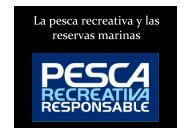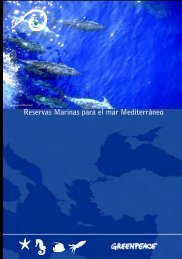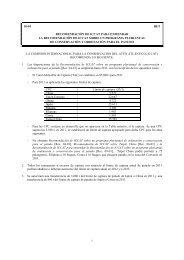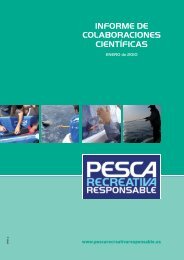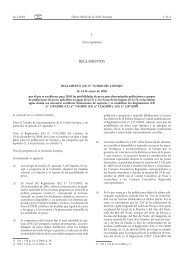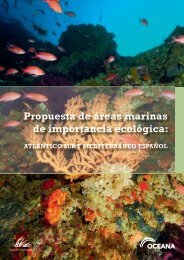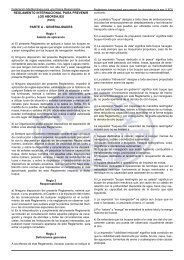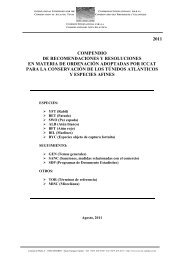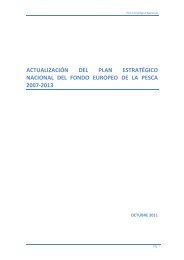C. hippurus - Confederación Española de Pesca Recreativa ...
C. hippurus - Confederación Española de Pesca Recreativa ...
C. hippurus - Confederación Española de Pesca Recreativa ...
Create successful ePaper yourself
Turn your PDF publications into a flip-book with our unique Google optimized e-Paper software.
DOLPHINFISH (C. <strong>hippurus</strong>) RECREATIONAL<br />
FISHING IN THE MEDITERRANEAN SEA, A<br />
THEORETICAL TOOL FOR SCIENTISTS AND<br />
MANAGERS<br />
A CopeMed II contribution to:<br />
CopeMed II - MedSudMed Workshop on Fisheries<br />
and appraisal of Coryphaena <strong>hippurus</strong><br />
5-6 July, 2011<br />
Palermo, Italy<br />
Juan A. Camiñas<br />
FAO-CopeMed II, Coordinator<br />
Málaga (Spain), November 2011
CopeMed II Occasional Paper Nº 4<br />
(GCP/INT/028/SPA – GCP/INT/006/EC)<br />
CopeMed II (Co-ordination to Support Fisheries Management in the Western and<br />
Central Mediterranean) is a project un<strong>de</strong>r the responsibility of the Fisheries and<br />
Aquaculture Department of the Food and Agriculture Organization of the United<br />
Nations (FAO), executed by the Marin and Inland Fisheries Service and<br />
Coordinated from the Office of the Project in Málaga (Spain).<br />
CopeMed II is financed by the DG Mare of the European Commission and the<br />
Government of Spain.<br />
CopeMed II Occasional Papers is a series of non peer<br />
reviewed documents prepared in the frame of the<br />
activities of the Project in cooperation with the CopeMed<br />
II countries, other FAO Mediterranean projects or by<br />
other reasons for: technical support to international<br />
meetings, working group meetings, joint assessment<br />
meetings on shared stocks within the CopeMed region<br />
and with other FAO projects; and report concerning other<br />
activities.<br />
The documents inclu<strong>de</strong>d in the Occasional Papers series<br />
are based on work carried out by researchers from the<br />
institutions involved in CopeMed II, on contributions<br />
prepared by external experts to the project and on joint<br />
works organized by or with the support of other FAO<br />
projects.<br />
CopeMed II Occasional Papers are available on the<br />
website of the CopeMed II Project www.faocopemed.org<br />
For reference, this document should be cited as follow:<br />
Camiñas J.A., 2011. Dolphinfish (C. <strong>hippurus</strong>) recreational fishing in the Mediterranean Sea, a<br />
theoretical tool for scientists and managers. A CopeMed II contribution to the CopeMed II -<br />
MedSudMed Workshop on Fisheries and appraisal of Coryphaena <strong>hippurus</strong> (Palermo, Italy. 5-6<br />
July, 2011). GCP/INT/028/SPA-GCP/INT/006/EC. CopeMed II Occasional Paper Nº 4: 7 pp.<br />
1
1. Introduction<br />
The participation of recreational fishing actors in the management process of some<br />
fisheries resources is an opportunity for fishermen, scientists and administrations to<br />
achieve the goals of the Co<strong>de</strong> of Conduct for responsible fisheries of the FAO (FAO,<br />
1995) and to improve the implementation of the principles and recommendations of the<br />
Ecosystem Approach to Fisheries Management (EAF) in the Mediterranean Sea, in the<br />
framework of the GFCM.<br />
The Co<strong>de</strong> of Conduct promote the participation of all the interested domestic parties,<br />
having a legitimate interest in the use of fisheries resources, in the management process,<br />
by establishing arrangements for consulting them to gain their collaboration in achieving<br />
responsible fisheries, and the (EAF) recommends the stakehol<strong>de</strong>rs participation. Such<br />
participation may be implemented at many different levels of involvement of the<br />
stakehol<strong>de</strong>rs in the management process in data collection, knowledge-building, option<br />
analysis, <strong>de</strong>cision-making and even implementation, including enforcement (Garcia et al,<br />
2003).<br />
The GFCM recognizes the important role of the recreational fisheries in fishery<br />
management. Moreover, in 2010, a GFCM transversal meeting on recreational fisheries<br />
was un<strong>de</strong>rtaking providing with recommendations to the 2010 GFCM meeting.<br />
2. Dolphinfish fisheries in the Mediterranean Sea. The Spanish situation<br />
Dolphinfish is an epipelagic species inhabiting open waters, but also approaching the<br />
coast following ships and assembling in small groups below floating objects. It has<br />
pelagic eggs and larvae and spawning generally occurs during summer (June to<br />
September). It is worldwi<strong>de</strong> distributed in tropical and subtropical seas and is present in<br />
the Mediterranean Sea. Fishing aggregation <strong>de</strong>vices (FADs) are used to concentrate<br />
Dolphinfish before the nets are set. It is caught by trolling and by tuna longlining, and<br />
also occasionally with purse seines and driftnets (FAO Fish-Fin<strong>de</strong>r, 2011).<br />
A traditional small-scale fishery is carried out in the central Mediterranean (Sicily, Malta<br />
and Tunisia) and western part of the basin (Majorca Island) during summer-fall using<br />
FADs. This highly migratory middle size pelagic fish seems to be a single stock in the<br />
central-western Mediterranean and should be jointly managed (COPEMED, 2003). The<br />
Balearic island artisanal fishery (Masutti & Morales Nin, 1995) means to be the most<br />
important in Spanish waters.<br />
This species is also recognized as a premier game and food fish wherever it is found.<br />
Historically harvested almost wholly by recreational fishermen around the world, only in<br />
recent <strong>de</strong>ca<strong>de</strong>s caught the attention of commercial fishermen. Today the species is a<br />
shared stock between recreational and commercial interests (Hammond, Cooperative<br />
Science Services, LLC).<br />
The bearing of recreational fisheries worldwi<strong>de</strong> and in the Mediterranean is very<br />
important, consi<strong>de</strong>ring that only U.S. sports fishermen harvested more than 1.45 million<br />
Dolphinfish from the Gulf of Mexico, Atlantic and Caribbean in 2008. (MRFSS Data,<br />
Dolphinfish Research Newsletter. August 2009).<br />
2
Recreational fisheries are an important regional issue for the GFCM. A recent report of<br />
the GFCM (GFCM, 2011) stated that basic recreational fisheries resource needs to be<br />
well managed but information on the state and trends are largely lacking to support<br />
recreational fishing regulations and management.<br />
Recreational fisheries in Spanish Mediterranean waters are well <strong>de</strong>veloped, and the<br />
Majorca recreational fisheries targeting Dolphinfish are well known by professional<br />
artisanal fishermen and are or could be questioned due to conflicts between users.<br />
According to the Confe<strong>de</strong>ration Española <strong>de</strong> <strong>Pesca</strong> <strong>Recreativa</strong> Responsable, Spanish<br />
recreational fisheries consist of 100.000 boats and the socio-economic impact is 1.000<br />
million € annually. This Confe<strong>de</strong>ration is an observer of the GFCM, participating in<br />
different sub committees.<br />
3. An approach to recreational fisheries information and data on Dolphinfish<br />
Recreational fisheries are very important in all the Mediterranean countries. Some studies<br />
on recreational fisheries in Mediterranean countries were presented during the transversal<br />
workshop of the GFCM (2010) referred to Italy (Colella et al., 2010), Balearic Islands in<br />
Spain (Morales-Nin and Palmer, 2010), Turkey (Unal and Özgül, 2010), Maroc (Zahri<br />
and Ab<strong>de</strong>llaoui) including one presentation on spearfishing in Spain (Sagué Pla, 2010).<br />
Recreational un<strong>de</strong>rwater fisheries are practically unknown from the point of view of the<br />
number of fishermen, target species or production.<br />
Studies on Dolphinfish captured, recreational fisheries and spearfishing are very rare. In<br />
this document we propose to explore new digital formats that inclu<strong>de</strong> information on this<br />
species in the Mediterranean Sea in or<strong>de</strong>r to improve our knowledge and the biological<br />
information as well as looking for new possibilities of monitoring and basic data<br />
gathering. The aim is to facilitate the organisation of a monitoring framework including<br />
most of the recreational fisheries information set as requested by the GFCM WG on<br />
recreational fisheries.<br />
A preliminary review of existing information on Spanish sport fishing fora websites has<br />
begun in or<strong>de</strong>r to investigate whether biological and fishing information provi<strong>de</strong>d by<br />
sport fishermen could be used to know more about the biology and ecology of<br />
Dolphinfish in the Mediterranean. The review was done without intending to obtain<br />
statistical data but to investigate whether that information could be used as an additional<br />
valid source for researching into the state of the resource and applying this approach in<br />
the Mediterranean region.<br />
From the information of recreational fisheries websites and from the information<br />
provi<strong>de</strong>d by the fishermen in digital fora, some conclusions that could improve<br />
un<strong>de</strong>rstanding of this species in the Spanish Mediterranean have been drawn and in some<br />
way facilitate the <strong>de</strong>velopment of a database sport fishing of this species.<br />
As first attempt to test this methodology three websites were reviewed: the web<br />
www.pescamediterraneao2.com, which inclu<strong>de</strong>s information from Spanish fishermen in<br />
the Mediterranean; the fishing forum web<br />
http://foro.lataberna<strong>de</strong>lpuerto.com/showthread.php?t=22489; and the website of the<br />
3
Spanish Confe<strong>de</strong>ration of Responsible Recreational Fisheries<br />
(http://www.pescarecreativaresponsable.es), that is a confe<strong>de</strong>ration that brings together<br />
13 associations and fe<strong>de</strong>rations of recreational fishing from boats on the Spanish coast.<br />
4. The recreational Dolphinfish fishery in Spanish Mediterranean Sea: Preliminary<br />
results<br />
The information obtained that can be useful for the WG inclu<strong>de</strong>: date, fisherman base<br />
location, fishing area, fishing <strong>de</strong>pth, fishing period of the year, number of catch, weight<br />
of the specimens, type of gear used, the <strong>de</strong>stination of specimens (consumption,<br />
distribution) and so on. A summary of the information obtained from the visited websites<br />
is shown next:<br />
Gear types and fishing methods: according to these forums, Dolphinfish boat fishing is<br />
carried out in very different ways, from spinning and jigging to the more usual trolling. It<br />
is also caught baiting the water with sardine to attract them. Since the species tends to<br />
shelter, it is caught near the feeding and fattening aquaculture cages and using floating<br />
<strong>de</strong>vices. It is also mentioned that using trolls, once a specimen is attracted to the boat, if<br />
left hooked in the water, the presence of the first one usually attract new specimens<br />
increasing the boat captures.<br />
Fishing strategy and fishing methods: it is highly varied, from which the one that go<br />
fishing after consulting in a forum some information about the presence of specimens in<br />
their area, to the ones that have information about the fishing season and abundance<br />
because of their greater experience, or those mentioning that "we must observe any<br />
movement of seabirds, floating <strong>de</strong>bris or some fish shoals, that will guarantee a good<br />
fishing". Some time <strong>de</strong>tection of Dolphinfish schools is ma<strong>de</strong> by observing the sea birds<br />
flying around FADs, the movement of the water surface, or other indicators.<br />
Depth and fishing zones: are varied, from 60-70 m <strong>de</strong>ep (Saint Pedro <strong>de</strong>l Pinatar,<br />
southern Murcia) to over 300 m (<strong>de</strong>ep-sea for fishing competition) but it seems that<br />
sometimes can be caught near the coast ("I saw 15 m from the coast the -queen of<br />
Dolphinfish-, nearly 1m long one") or in lower <strong>de</strong>pths (20 to 30 m in January in<br />
Tarragona), or even in some bays (Alicante, December 2003). Fishing is reported in<br />
Tarragona, Baleares, Valencia, Alicante, Murcia and Cabo <strong>de</strong> Gata (Andalucía).<br />
Fishing seasons: the main fishing season runs from June to September (although in<br />
November is reported in Majorca). Nevertheless captures are reported during the whole<br />
year: in April 2004 a fisherman from Barcelona says: "I caught fifteen Dolphinfish and I<br />
returned more than half of them to the water as they were so small, keeping the rest that<br />
would not exceed 1 Kg". The fishing season varies from one area to another, being able<br />
to get valuable information on the distribution areas and sizes in different mainland<br />
coastal and Balearic Islands areas: "In June 2003, in Javea-Moraira it was caught a<br />
specimen 15-25 miles from the coast. In Valencia, November 22, one was caught 30<br />
miles from the coast. In Almería, very few reported in November 2003".<br />
Sizes and / or weight of specimens catch: data tables can be ma<strong>de</strong> with sizes and / or<br />
specimens weights information, in different areas and periods of the year. For example, it<br />
4
was reported: "seven small Dolphinfish caught, all with little more than several inches (><br />
20 cm) on November 11, 2003. In October, in Alicante, 200 gr specimens. In December,<br />
one specimen with a little less than 1 Kg in southern of Salou (Tarragona)”. What it is<br />
clear from the anglers’ information is that mean length composition of the Dolphinfish<br />
increase during the summer fishing season in Spanish waters.<br />
Biology of the species: from October to December and in some cases in January, 200 gr<br />
specimens are reported (Alicante, October 2003), and 1 Kg specimen (Tarragona,<br />
December). Such kind of data may provi<strong>de</strong> information about areas and recruitment on<br />
the Spanish coast. In this period it is also commented that "the size is increased the entire<br />
months of September and October, and then in November they disappear”.<br />
Abundance in the sea: most fishermen give information about their fishing zones and if<br />
the fishing is good or not, which could i<strong>de</strong>ntify some key areas in the sea where adults<br />
and juveniles are concentrated: "Near Denia there is a lot of Dolphinfish (April 2003),<br />
most specimens with more than 1 Kg and some with more than 2kg".<br />
Total catch per vessel: only some information of total catch, primarily in number of<br />
specimens (from 200 to 1 or 2, with varied sizes). The comments, sometimes comment<br />
total catch: "Catch may reach nearly 200 kg in 1 hour time of 3-4 Kg specimens in<br />
Tabarca. In August, fish over 2 kg are caught in Alicante. 150-200 Dolphinfish were<br />
caught 3 miles from San Carlos <strong>de</strong> la Rápita, in 6 hours, in 2007".<br />
Spanish Confe<strong>de</strong>ration of Responsible Recreational Fishing<br />
(http://www.pescarecreativaresponsable.es): it is a non-governmental, non-profit<br />
organization that brings together several associations and fe<strong>de</strong>rations of recreational sea<br />
fishing in Spain. It is committed to promote the practice of responsible recreational<br />
fishing, the spread of its co<strong>de</strong> of conduct based on respect for the marine environment<br />
and sustainability of fishery resources. According this Confe<strong>de</strong>ration, the Spanish fishery<br />
represents 100.000 boats and the Socio-economic impact is 1.000 million € annually.<br />
This Confe<strong>de</strong>ration is involved in scientific activities (mainly tagging programs) in<br />
collaboration with Spanish scientific institutions: IEO, CSIC and AZTI, three important<br />
marine research institutions in Spain.<br />
Registers from National and International competition<br />
Data on catch could also be obtained through the national and international competitions<br />
registers. As an example we inclu<strong>de</strong> here the International Fe<strong>de</strong>ration of Sporting Sea-<br />
Angling, (http://www.fipsmer.org) with a register called F.I.P.S./M. Competition World<br />
Record Catches with different lists where they inclu<strong>de</strong> the biggest captures during<br />
championships, including two Dolphinfish:<br />
Dolphinfish C. <strong>hippurus</strong>; 13,0 Kg; date: 24.06.2003 in Dakar, Senegal during the<br />
World Championship; fisher: Carlos Garin, Spain<br />
Dolphinfish C. <strong>hippurus</strong>; 20,4 Kg; date: 26.08.2003 in Alicante , Spain during the<br />
Club Championship; angler: Cristobal Miravet Sturm, Spain<br />
This second record corresponds to a Dolphinfish captured in the Mediterranean.<br />
5
Tagging research programs on Dolphinfish<br />
The USA Marine Resources Division of the South Carolina Department of Natural<br />
Resources (SCDNR) initiated a study on Dolphinfish in 2002 adopting a tagging program<br />
in collaboration with the recreational anglers (http://www.dolphintagging.com). The<br />
Tagging Study is a scientific research project conducted to the fishermen with the aim of<br />
establishing the temporal and spatial occurrence, movement patterns and essential habitat<br />
of the species in the USA territorial waters, Gulf of Mexico, Western North Atlantic and<br />
Caribbean Sea. It is also inten<strong>de</strong>d to foster more research on the biology and behaviour<br />
of Dolphinfish. The program has been extremely successful, having more than 11,000<br />
fish marked with the majority released along the U.S. Atlantic coast.<br />
2005 SPECIAL RECAPTURE MAPS 2010 RECAPTURES MAP<br />
Dolphinfish tagged off the U.S. East Coast have travelled to southern Azores Islands in<br />
the Eastern North Atlantic, Puerto Rico, Antigua, St. Kitts, Venezuela, Mexico and Cuba.<br />
The Confe<strong>de</strong>ración Española <strong>de</strong> <strong>Pesca</strong> <strong>Recreativa</strong> Responsable is associated to this<br />
tagging program and could be an important contributor to this activity in Spain.<br />
5. Some conclusions and recommendations<br />
Recreational fisheries targeting Dolphinfish in western Mediterranean are an<br />
important annual activity for anglers based in several ports of Balearic Islands,<br />
Catalonia, Valencia and north of Cabo <strong>de</strong> Gata in Spain.<br />
The total catch and the number of anglers involved in the capture of this species in<br />
Spain are unknown at present.<br />
Web pages of professionals and digital fora on recreational fisheries are an important<br />
source of information related to the biology, distribution, fishing periods and fishing<br />
zones, weight and sizes, production, fishing methods and environmental variables<br />
(fishing <strong>de</strong>pths, sea state, winds, etc).<br />
Registers from National and International competitions could be a source of<br />
information on Dolphinfish.<br />
Information provi<strong>de</strong>d by recreational fishers could be incorporated to a data base of<br />
the Spanish recreational Dolphinfish fishery.<br />
Catch occurs from January to December in coastal and offshore areas with peaks of<br />
captures during the end of the summer and autumn.<br />
Dolphinfish average length composition in Spanish Mediterranean waters increase from<br />
April-May until the end of October.<br />
Target sizes (>1Kg) disappear in some areas in November.<br />
6
During October, November and December anglers from Majorca and from coastal<br />
areas (Barcelona, Alicante) report of catch of small Dolphinfish (




